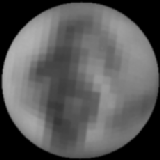
Pluto

Pluto is the farthest planet from the Sun (usually) and by far the smallest. Pluto is
smaller than seven of the solar system's moons (the Moon, Io, Europa, Ganymede, Callisto,
Titan and Triton).
orbit: 5,913,520,000 km (39.5 AU) from the Sun (average)
diameter: 2274 km (current estimate includes an error margin of almost one percent)
mass: 1.27e22 kg
In Roman mythology, Pluto (Greek: Hades) is the god of the underworld. The planet received
this name (after many other suggestions) perhaps because it's so far from the Sun that it
is in perpetual darkness.
Pluto was discovered in 1930 by a fortunate accident. Calculations which later turned out
to be in error had predicted a planet beyond Neptune, based on the motions of Uranus and
Neptune. Not knowing of the error, Clyde W. Tombaugh at Lowell Observatory in Arizona did
a very careful sky survey which turned up Pluto anyway.
After the discovery of Pluto, it was quickly determined that Pluto was too small to
account for the discrepancies in the orbits of the other planets. The search for Planet X
continued but nothing was found. Nor is it likely that it ever will be: the discrepancies
vanish if the mass of Neptune determined from the Voyager 2 encounter with Neptune is
used. There is no tenth planet.
Pluto is the only planet that has not been visited by a spacecraft. Even the Hubble Space
Telescope can resolve only the largest features on its surface.
Fortunately, Pluto has a satellite, Charon. By good fortune, Charon was discovered (in
1978) just before its orbital plane moved edge-on toward the inner solar system. It was
therefore possible to observe many transits of Pluto over Charon and vice versa. By
carefully calculating which portions of which body would be covered at what times, and
watching brightness curves, astronomers were able to construct a rough map of light and
dark areas on both bodies.
Pluto is the second most contrasty body in the Solar System
(after Iapetus). Exploring the origin of that contrast is one of the high-priority goals
for the proposed
Pluto Express mission.
There are some who think Pluto would be better classified as a large asteroid or comet
rather than as a planet. Some consider it to be the largest of the Kuiper
Belt objects (also known as Trans-Neptunian Objects). There is considerable merit to the
later position, but historically Pluto has been classified as a planet and it is
likely to remain so.
Pluto's orbit is highly eccentric. At times it is closer to the Sun than Neptune (as it
was from January 1979 thru February 11 1999). Pluto rotates in the opposite
direction from most of the other planets.
Pluto is locked in a 3:2 resonance with Neptune; i.e. Pluto's orbital period is exactly
1.5 times longer than Neptune's. Its orbital inclination is also much higher than
the other planets'. Thus though it appears that Pluto's orbit crosses Neptune's, it really
doesn't and they will never collide.
Like Uranus, the plane of Pluto's equator is at almost right angles to the plane of its
orbit.
The surface temperature on Pluto is not well known but is probably between 35 and 45
Kelvins (-228 to -238 C).
Pluto's composition is unknown, but its density (about 2 gm/cm3) indicates that it is
probably a mixture of 70% rock and 30% water ice much like Triton. The
bright areas of the surface seem to be covered with ices of nitrogen with smaller amounts
of (solid) methane, ethane and carbon monoxide. The composition of the
darker areas of Pluto's surface is unknown but may be due to primordial organic material
or photochemical reactions driven by cosmic rays.
Little is known about Pluto's atmosphere, but it probably consists primarily of nitrogen
with some carbon monoxide and methane. It is extremely tenuous the
surface pressure being only a few microbars. Pluto's atmosphere may exist as a gas only
when Pluto is near its perihelion; for the majority of Pluto's long year, the
atmospheric gases are frozen into ice. Near perihelion, it is likely that some of the
atmosphere escapes to space perhaps even interacting with Charon. The Pluto
Express mission planners want to arrive at Pluto while the atmosphere is unfrozen.
The unusual nature of the orbits of Pluto and of Triton and the similarity of bulk
properties between Pluto and Triton suggest some historical connection between
them. It was once thought that Pluto may have once been a satellite of Neptune's, but this
now seems unlikely. A more popular idea is that Triton, like Pluto, once
moved in an independent orbit around the Sun and was later captured by Neptune. Perhaps
Triton, Pluto and Charon are the only remaining members of a large
class of similar objects the rest of which were ejected into the Oort cloud. Like the
Earth's Moon, Charon may be the result of a collision between Pluto and another
body.